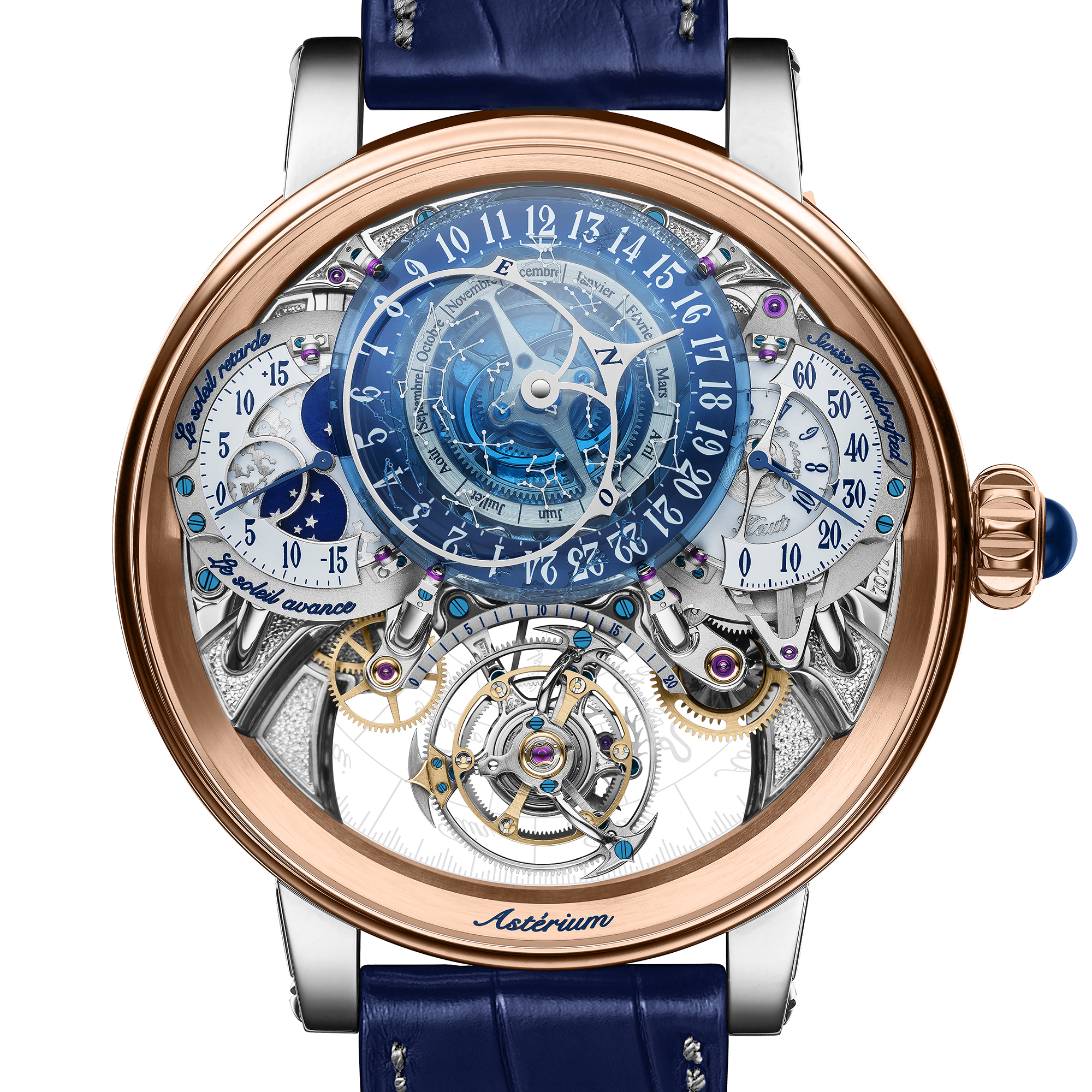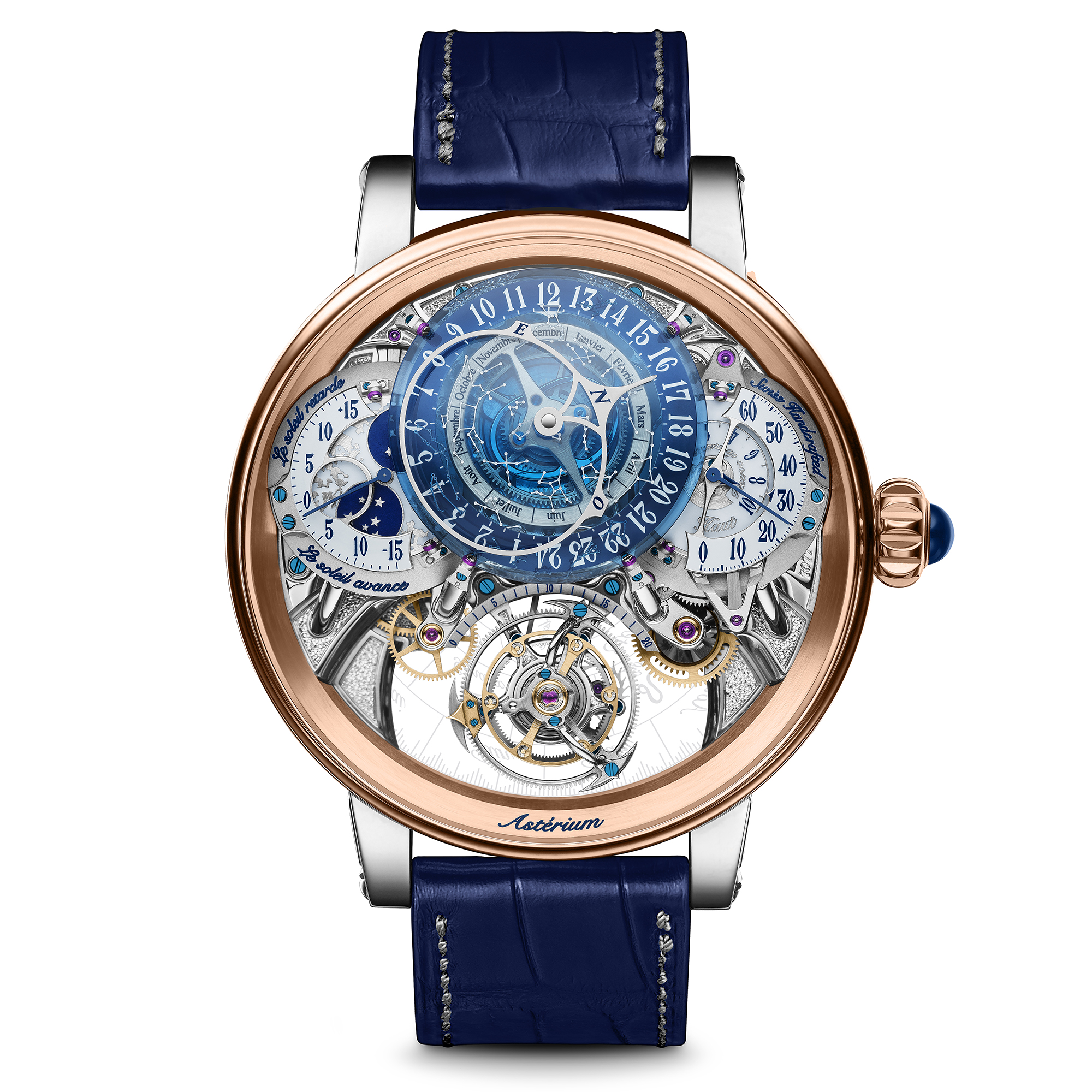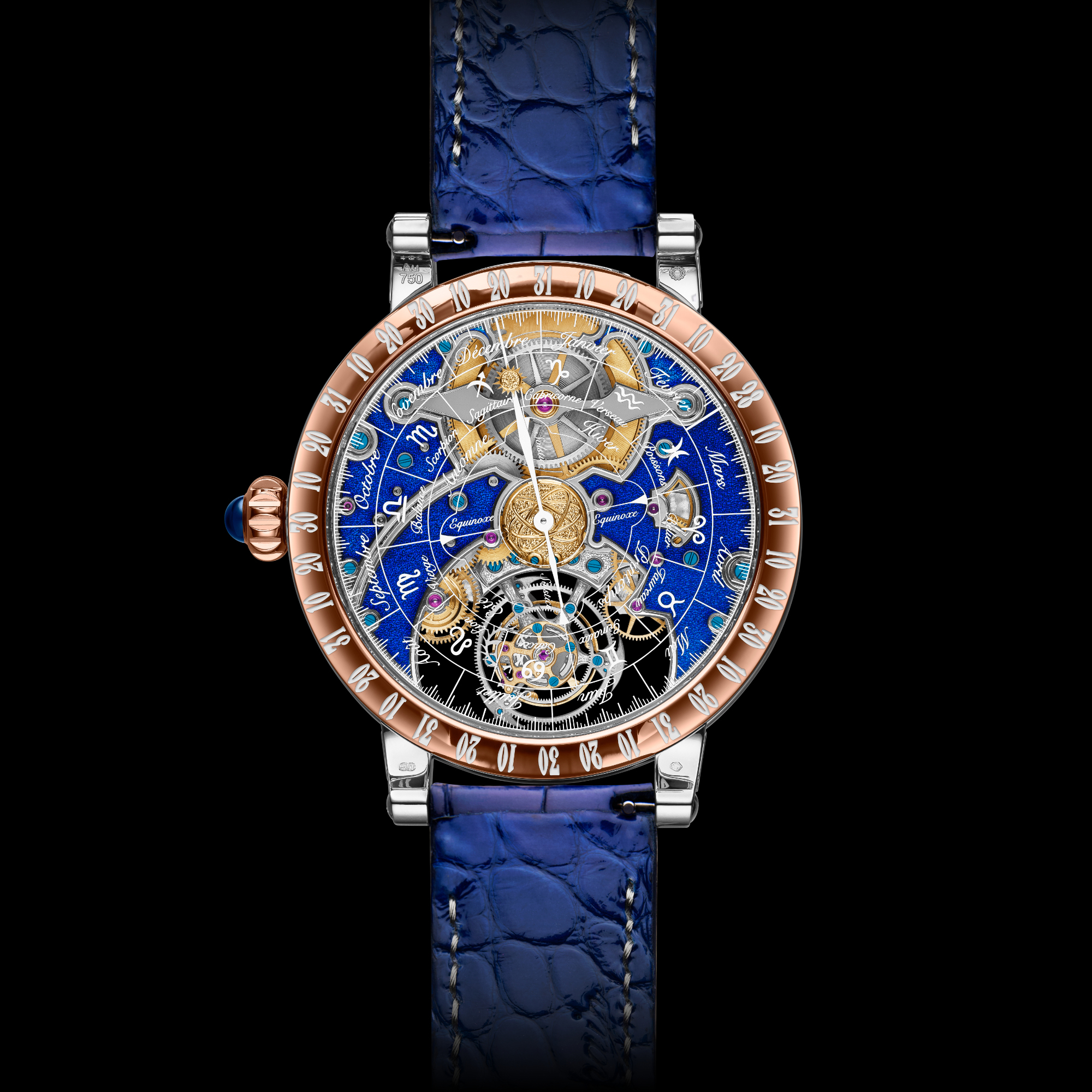
Récital 20 Astérium
Power reserve: 240 h, 18000 vph
Skeleton movement
Solstice, equinox, astrological zodiac
Mechanical Exception: Récital 20 Asterium Unique Piece (bezel and back case in red gold, body in white gold, plate and crown in red gold)
The Récital 20 Asterium (sky seen from the earth) is a key timepiece in BOVET's collection of Astronomical Complications, which also includes the Récital 18 Shooting Star (the earth with 24 time zones seen from the sky) and the Récital 22 Grand Récital (Tellurium).
Housed in BOVET’s trademarked Writing Slope case, in this unique piece a combination of 18K red and 18K white gold, the Asterium really puts this spectacular movement on full display — and what a movement it is.
Where should we start?
How about with the most visual aspect of the timepiece? Front and center is the night sky map of the stars and constellations, which are laser-engraved and then filled with Super-LumiNova on a dome of translucent blue quartz -- functional, precise and intuitive all at once. To ensure utmost realism, the highest stars in the sky are depicted at the top of the dome while the lowest stars nearer the horizon appear on the periphery of the display aperture.
Added to this is a sidereal calendar. The duration of a complete Earthly orbit (known as a sidereal year) is 365 days, 6 hours, 9 minutes and 9.77 seconds, or an unchanging 365.25 days. For obvious reasons, the Gregorian calendar was obliged to round down the number of days in a year to 365 and added an extra day every four years, (the leap year) to compensate for the remaining time. The calendars usually employed in watchmaking are all based on the Gregorian calendar, but the use of this calendar to drive the night sky would result in a significant cumulative error when displaying the equation of time.
The night sky and the collection of sidereal indications on the Astérium® are for this reason governed by an annual calendar calculated on a 365.25-day cycle to reflect the real duration of one full terrestrial orbit. Thanks to this combination of display and horological exactitude, the instantaneous position of the stars in the sky is displayed with unrivalled precision.
While complex engineering ingenuity went into developing the Astérium®, its mechanism and winding device are designed to be simple, intuitive and reliable, as can be seen by merely turning the timepiece over and looking through the transparent sapphire crystal covering the entire movement. It features a host of graduations linked to the astronomic indications through which a single central hand travels. This hand is driven directly by the annual calendar, and therefore performs a complete rotation once every 365.25 days. An annual calendar (dates and months) is graduated on the case-back bezel and serves to precisely regulate the night sky.
Rapidly setting the annual calendar with the crown disconnects the hours and minutes hands, and enables both the position of the night sky and thus all sidereal information to be adjusted both quickly and easily. To do this, the wearer simply moves the central hand forward until it reflects the correct date before adjusting the time with the crown in its middle position. This operation takes far less time than adjusting a perpetual calendar would, and does not require a corrector.
The same hand also travels along a graduation indicating the signs of the zodiac, symbolized by the constellations in front of which the sun appears throughout the year – hence the delicately hand-engraved sun that is riveted to the part of the hand that passes over this section. The seasons are also indicated further inside the timepiece, as are the solstices and equinoxes.
Returning to the front of the timepiece unveils some new additional indications. The lower left- and right-hand sections of the night sky overlook two double hemispheric indicators, while on the left, a hemispheric precision moon phase lingers above the equation of time indicator.
On the lower right-hand section of the night sky is a double hemispheric indicator positioned symmetrically opposite the moon phase and equation of time displays. This shows the power reserve and its ten days of autonomy via an internal dome that revolves beneath a fixed hour-marker. The retrograde minutes hand is positioned above it and displayed on the periphery.
In accordance with astral time, the hours pass concentrically across the night sky on a 24-hour dial that is positioned beneath and visible through the transparent quartz. To ensure intuitive use and optimal legibility, the hour hand has been designed to execute three functions simultaneously: it indicates the time, points to the north to facilitate map-reading, and carries the elliptical window characteristic of the night sky. Following the curves of the sapphire dome, this triple hand alone symbolizes the Manufacture’s truly diverse range of skills. From its development and its many delicate hand-crafted decorative flourishes to the hi-tech virtuosity that went into its machining, the creation of this hand is a concentration of technical feats all masterfully realized by the BOVET 1822 artisans.
Finally, the seconds hand – indicating the base unit by which the precision of all time measurements is judged – is driven by the patented double-face flying tourbillon.
The moon phase and power reserve domes, as well as the quartz night sky dome, are adjusted by patented variable micrometric bearing-blocks composed of ruby runners. This ingenious mechanism is extremely energy-efficient and has already proven its worth in the movement of the Récital 18 Shooting Star®.
The patented double face tourbillon which regulates the Récital 20 Astérium® is equipped with a variable inertia balance wheel. The six collets distributed along the surface of the felly help refine dynamic adjustment for even better chronometry. And once completed and adjusted, each balance wheel is carefully selected and matched with the balance-spring with which it will form the best possible pairing. Through their manufacture of traditional balance wheel and balance-springs, BOVET 1822 watchmakers constantly redefine the boundaries of isochronism and chronometry. The three arches on the bridge of the titanium carriage – all rounded-off and polished by hand – expertly protect the heart of the timepiece. Their design is suggestive of a Gothic vault, of a cathedral without a roof open to the universal magic of stellar mechanics.
The tourbillon carriage wheel and the seconds hour-marker screwed onto it are on the same level as the plate. Two levels of bridges then fan out from the center of the tourbillon carriage. The upper bridges are screwed to the bottom level by hand-polished pillars, which ensure harmonious volumes and draw the gaze.
Finally, the three domes overlook the entire movement, offering a panoramic view of time and space that is both poetic and original.
The decor of the movement, with its 771 components, matches its ingenuity and innovative structure. For maximum elegance, the Manufacture’s engravers have chosen subtle and delicate chiseling to decorate the surface of the bridges and plate. The surface demonstrates all the finesse of graining and all the brilliance of the bris de verre motif. This contrasts perfectly with the framework of polished angles tracing the contours of the bridges, and guarantees a clear reading of both the night sky and the sapphire rear dial, all the while affording the admiring observer a clear view of the movement’s architecture and decoration.
The power reserve of this timepiece is a spectacular 10 full days. Even though setting is very easy, it’s a shame to let such a complicated timepiece run down, so Mr. Raffy insisted on a long power reserve.



